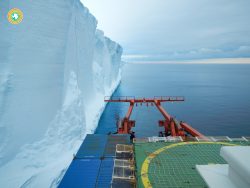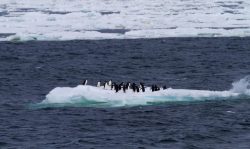
Growing up, most of us learned there were four oceans making up 71% of earth’s surface: The Arctic, Indian, Pacific and Atlantic. Now, there are five. The Southern Ocean is the most recent addition, officially recognized by National Geographic in June of 2021 on World Ocean Day. While the other four oceans are defined by continental boundaries, the Southern Ocean is different: it is the only ocean connecting the other oceans through a current that circles the entire globe.
Though this official designation from National Geographic is novel, the Southern Ocean in the scientific community is not new — researchers have recognized its distinct oceanographic properties since the early 1940s. David M. Karl, a professor of oceanography at the University of Hawaii proposed naming this body of water to the Board of Geographic Names in 1999 and it has been unofficially recognized by NOAA ever since. Prior to June, there was disagreement between nations on where the boundaries lie but it has now been decided the Southern Ocean is the water circling Antarctica at latitude 60 degrees south.
With a unique and different current pattern than the other four oceans, this fifth ocean carries great ecological importance for our planet. One distinct characteristic is the Antarctic Circumpolar Current (ACC). The ACC connects the Indian, Atlantic and Pacific Oceans, with the exception of Drake Passage and the Scotia Sea, with currents flowing from west to east circling Antarctica. The ACC is the strongest current on Earth and only place that allows for water to completely circle the planet unhampered. This essentially acts as a barrier for warmer waters flowing from the north to the south, and aids in surface water mixing with deep water, playing a significant role in global ocean heat uptake and storage. The ACC also ultimately propels what is known as the global conveyor belt, moving water around the globe while providing vital nutrient cycling.
The ACC isn’t the only thing distinctive to the Southern Ocean. It also tends to have lower temperatures and salinity due to melting sea ice, which translates to organismal life that is quite different from other oceans. “This area is of particular interest to many scientists because it is a high nutrient low chlorophyll zone,” says Jodi Young, professor of oceanography. “Despite lots of major nutrients like nitrogen and phosphorus for phytoplankton to grow, they didn’t seem to be abundant in the Southern Ocean. It was discovered that iron, another essential nutrient but needed in much lower concentrations was limiting phytoplankton growth in the Southern Ocean.”
Yet the cold environment and low salinity make it a really unique place for ecology with organisms who are well adapted to survive such extreme conditions such as giant worms, spider crabs, ice fish and sea stars. “This current and the overall circulation in this region, combined with strong seasonal cycles in sunlight, lead to many distinctive physical, chemical, and biological characteristics. In addition, the ocean here interacts significantly with the substantial seasonal cycle of sea ice found in this region and with the ice shelves along the coast of Antarctica, both of which help foster unique organisms and ecosystems found nowhere else in the world,” says professor of oceanography Alison Gray. “In fact, some studies estimate the vast majority of the water in the subsurface global ocean last came into contact with the atmosphere in the surface layer of the Southern Ocean. For this reason, the Southern Ocean is estimated to account for approximately one-half of the total oceanic uptake of the excess carbon dioxide added to the atmosphere by humans.”

While the naming of the Southern Ocean is new, the impacts from climate change and global warming are not. “Regions like the Western Antarctic Peninsula are seeing rapid increases in temperature and there’s been a major shift in penguin populations with a massive decline in Adelie penguins, being replaced by Gentoos. We are also seeing changes in phytoplankton and hence CO2 fixation (conversion into organic compounds for energy), but this is also very regionally driven,” Young tell us.
Official recognition may bring more attention to this unique environment and increase conservation efforts in the region. “As a high latitude region with significant interactions with the cryosphere (the frozen parts of earth’s oceans), the Southern Ocean is particularly sensitive to the effects of greenhouse-gas-induced warming,” Gray explains. “Many scientists are working to further our understanding of what drives changes in the Southern Ocean and to better predict the future evolution of the climate of the whole planet.”
With the designation of the Southern Ocean, National Geographic also launched Planet Possible, encouraging people to leave minimal impacts on our planet. Education is huge part of this too—if schools are teaching student about the five oceans that make our global body of water, students are able to learn about specifics of the region and the necessary conservation efforts to ensure thriving ecosystems in the Southern Ocean.

